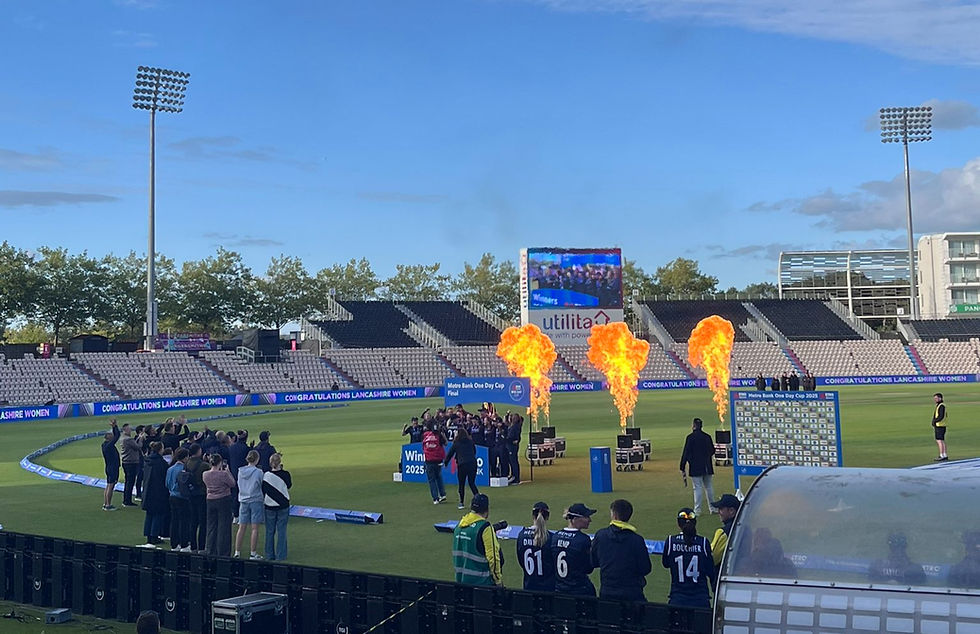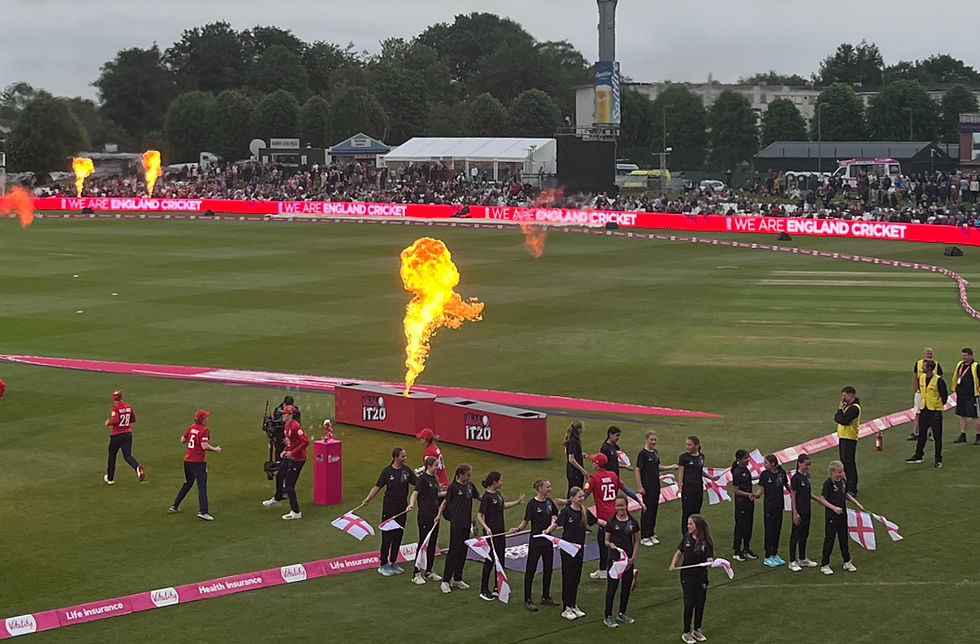Lancashire lift the One Day Cup to cap the “year of the chase”
- Richard Starkie

- Sep 22
- 6 min read
Lancashire (289/4 from 48.3 overs) beat Hampshire (288/6 from 50 overs) by six wickets.

The Metro Bank One Day Cup final began with renditions of “Abide with me” and “God save the King”. By the end, it would be fair to say, the more appropriate anthems would have been “Cwm Rhondda”, “The Fields of Athenry” and “Scotland the Brave” as Wales’s Seren Smale combined with Ireland’s Gaby Lewis to produce the match-winning contributions in order for the Scot Ailsa Lister to hit the winning run.
Lancashire won the toss and, as is customary in September, invited the opposition to bat on a cool but clear equinoctial morning. Lancashire were missing the tournament’s leading run scorer, Emma Lamb, as her prodigious totals this season had resulted in her being included in England’s World Cup Squad. Sophie Ecclestone is also in that squad. Lancashire’s overseas player had been Alana King, who is also preparing for the World Cup in Australia, so she had been replaced by Ireland’s captain Gaby Lewis as overseas player for the final five matches of the season.
Hampshire were missing Lauren Bell due to World Cup commitments, and tellingly, both their Australian overseas players, Charli Knott and Ellyse Perry. Combined with the injured Ella McCaughan, this left the impression that the Hampshire team in the final were not as strong as the Hampshire team that topped the league stage of the competition.
If Lancashire were hoping for the early morning moisture and the combined strengths of seam bowlers Kate Cross and Mahika Gaur to produce an early flurry of wickets, they were to be disappointed. Maia Bouchier and Rhianna Southby appeared largely untroubled as they stuck around for the first 15 overs, putting on 70 runs for the first wicket with well-judged cuts and drives threaded through the in-field and plenty of quick singles and scampered twos.
Southby’s departure, skying a Grace Potts slower ball to the grateful hands of Kate Cross at mid-on, brought in the dependable skipper, Georgia Adams, whose century in the mud and the rain of the semi-final had carried her team into this game. Adams works well as the anchoring partner of more aggressive batters and she proceeded to play this role first with Maia Bouchier, then Freya Kemp and finally Abbie Norgrove over the next 30 overs, contributing 77 of the 190 runs scored in that time. Norgrove did particularly well – she had the highest strike rate of the match for any player who scored over 30 – and helped Hampshire keep the scoreboard ticking over when it appeared they may get pinned back by the economic accuracy of Hannah Jones in the middle overs.
As Adams and Norgrove accelerated into the final 10 overs, taking 49 runs from the first five of those overs, it appeared that a score in excess of 300 was very much a possibility. But Adams was dismissed, telegraphing a pre-decided reverse sweep to the wily Fi Morris, who responded by spearing in a faster ball to demolish her stumps, then Norgrove was caught very well by Kate Cross, running round at long on. In the end, the innings petered out somewhat, with only 30 runs added for the loss of three wickets in the final five overs, leaving Hampshire on a creditable 288, but in this season of all seasons, when what is possible in a chase has been redefined time and time again, there was a sense that the door had been left ajar ever so slightly for a possible Lancashire victory, provided at least one of their batters could go very big.
Enter Gaby Lewis. Ireland’s captain. Before receiving the call from Lancashire, she was busy battling against the bowlers of Italy, Germany and the Netherlands at a small cricket club in Rotterdam in order to progress Ireland’s qualification to next year’s T20 World Cup. Now she stood on the biggest stage English county cricket had to offer. A tall, assured and classically orthodox batter, she is capable of strong defence and a range of aggressive strokes. Clearly relishing the opportunity to showcase her talent and make the most of the rich resources that English county cricket has to offer her, Lewis looked unflappable and her defence impenetrable as she faced Daisy Gibb and Freya Davies, Hampshire’s opening bowlers. A mix up at the end of the fifth over saw her opening partner, Alice Clarke, run out. What followed was the defining partnership of the match as Lewis and Seren Smale added a gross* of runs in 27 overs.
Mmm, I hear you muttering. How can 144 runs in 27 overs (5.3 runs per over) be a better contribution than 190 runs in 30 overs (6.3 runs per over) contributed by Adams and partners? The answer is to do with when the partnership happens. Adams’ wicket in the 46th over resulted in a collapse that meant that Hampshire didn’t achieve an overall 6 runs per over (ie a total in excess of 300). Smale’s dismissal in the 33rd over enabled new batters Morris, Threlkeld and finally Lister to start striking at over 100 from the start. Lewis also increased her overall strike rate from around 79 to 98 as Lancashire went through the gears, adding 111 in 15 overs (7.4 runs per over) from the time Smale was out. Ultimately, this is the advantage of chasing – you know exactly the rate that is required and can bat accordingly.
Jeopardy was never far away. Both Lewis (in the 25th over) and Smale (in the 30th) could and maybe should have been given run out when direct hits resulted in the benefit of the doubt going to the batter. Even in the 48th over, with 15 runs still needed from 16 balls, Lewis was dropped on the boundary by Bouchier, the ball then trickling into the boundary rope. On such fine margins do trophies and reputations hang.
At the end Lewis was unbeaten on 141. It was left to Elgin’s own Ailsa Lister, one of the breakout stars of this season to hit the winning run, provoking wild celebrations from the Lancashire players and staff. For several years now, Lancashire have had all the elements of a successful women’s team in place: an ethos of equity permeating the club from top to bottom, great in-house media coverage, pre-season tours, community engagement and the building of women’s facilities both at Old Trafford and a bespoke new women’s ground at Farington, just south of Preston. The only piece that was missing was success on the pitch. After lifting the T20 County Cup and now the Metro Bank One Day Cup this season, it would be fair to say that English county cricket has a new superpower.
Maybe it is worth adding that with great power comes great responsibility. I am sure that Hampshire will not be releasing a statement after the final criticising the umpires’ decisions to give Lewis and Smale not out. This is exactly what Lancashire did for a recent men’s match – a move which I think undermines both the laws of the game and the spirit of the game and does not reflect well on them as a club.
For Hampshire, this has been a really good season after the elevation of Charlotte Edwards to the role of England coach left them with a very disrupted start. Maybe they need to look at overseas recruitment for next year and consider whether they need to ensure availability for the knockout phase as a priority in their recruitment strategy. It could be argued that the recruitment of Perry was a PR success but a cricketing failure, her 12 wickets and 149 runs across eight matches perhaps not being the impact that was expected by the club, who presumably paid a lot more money for her services than Lancashire have paid Gaby Lewis.
One player who will not feature for Hampshire next year is Freya Davies. The 30-year-old pace bowler, capped 35 times by England, played her final professional game in the final. She bowled with great control and was by far the most economical bowler for Hampshire, rounding off her career by taking the wicket of Ellie Threlkeld. It was sad to see a great servant of the game depart the stage for the final time, someone who truly spanned two eras and who modelled professionalism to those around her. One of the defining images of her was her care and support of the distraught Charlie Dean following the famous incident at Lord’s in which Dean was run out at the non-striker’s end by Deepti Sharma. Even in retirement, as she enters the legal profession, she models good professional habits to the next generation, many of whom seem determined to drop education at the earliest possible opportunity and gamble everything on making a fortune in cricket.
And so farewell 2025 cricket season! It has been the year of the chase, where scores of over 300 are no longer safe, when glorious sunshine and weeks of heatwave created a paradise for batters – maybe we will talk about 2025 the way previous generations told me about 1947: Compton and Edrich batting under cloudless skies as thousands sought solace from the privations of post-war Britain by soaking in their glorious run-scoring. For us it will be the story of Lamb and Lewis, of Adams and Davidson-Richards, of Perrin and Bates, of Matthews and Mandhana, of Beaumont and Jones, of Elwiss and Bryce providing solace and joy to us in a sometimes-troubled world.
This is why we love cricket and this is why we will be back for more in 2026.
*(old English phrase meaning 12 dozen ie 144)







Comments